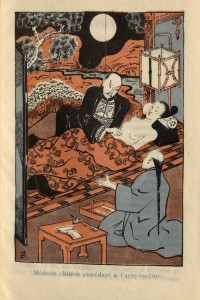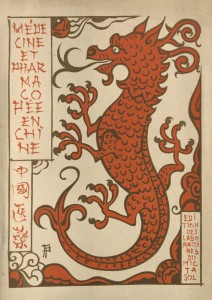This post is part of an ongoing series featuring items from the newly acquired Santo Domingo collection.
Médecine et pharmacopée en Chine is comprised of three volumes that are each bound with colored cord inside an illustrated paper cover. Published in early 20th-century France the volumes appear to explore medicine and pharmacology in China. Each individual volume begins with a beautiful color illustration depicting a topic related to Medicine, Pharmacy and Therapeutics, or Medical Superstitions.
One of the illustrations depicts the practice of acupuncture. It is interesting that the scientific benefits of acupuncture are still debated in present day. Though the exact origins of acupuncture are disputed most typically agree that it was being practiced during the Han Dynasty in China during the 2nd century.
 One of the difficulties in proving the effectiveness of acupuncture is that it is difficult to run a placebo control group since the very action involves piercing the skin with a needle. More traditional Western medicine has cautiously agreed that acupuncture can be effective for certain conditions though they admit they cannot exactly explain why it works. Regardless of proven scientific fact many people believe in acupuncture’s ability to relieve nausea and chronic pain and popularity of the practice has greatly increased in the past 20 years.
One of the difficulties in proving the effectiveness of acupuncture is that it is difficult to run a placebo control group since the very action involves piercing the skin with a needle. More traditional Western medicine has cautiously agreed that acupuncture can be effective for certain conditions though they admit they cannot exactly explain why it works. Regardless of proven scientific fact many people believe in acupuncture’s ability to relieve nausea and chronic pain and popularity of the practice has greatly increased in the past 20 years.
The third volume explores various medical superstitions that were commonly used in China. This illustration depicts a man using a rooster to help set a woman’s fracture. I think the idea is that using the rooster blood will assist in the healing process.
To learn more the Médecine et pharmacopée en Chine. [France] : Editions des Laboratoires du Mictasol, [192-?]. R601 .M48 can be found at the Countway Library at the Harvard Medical School in Longwood.
Thanks to Alison Harris, Santo Domingo Project Manager and Joan Thomas, Rare Book Cataloger at Countway for contributing this post.



